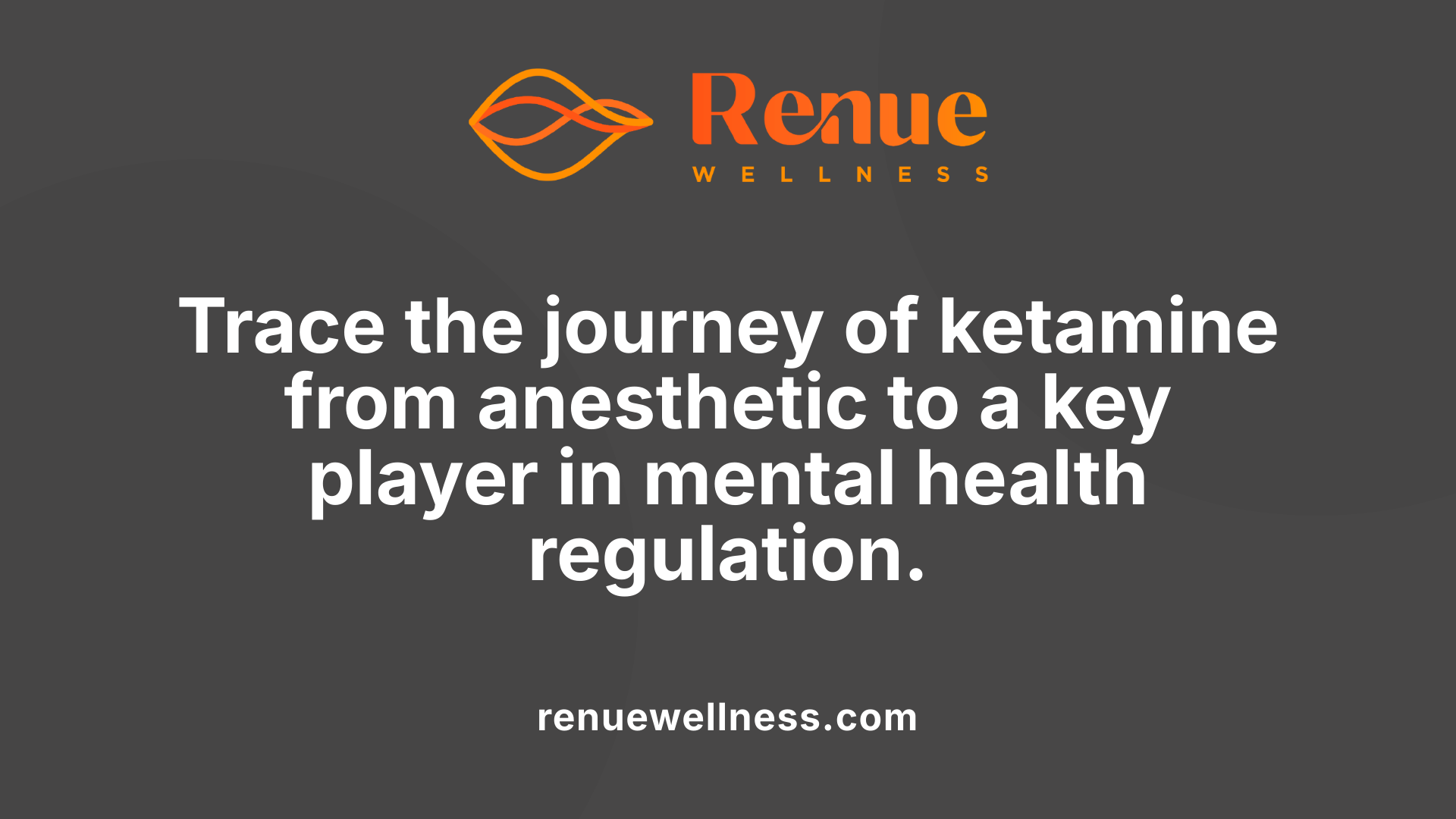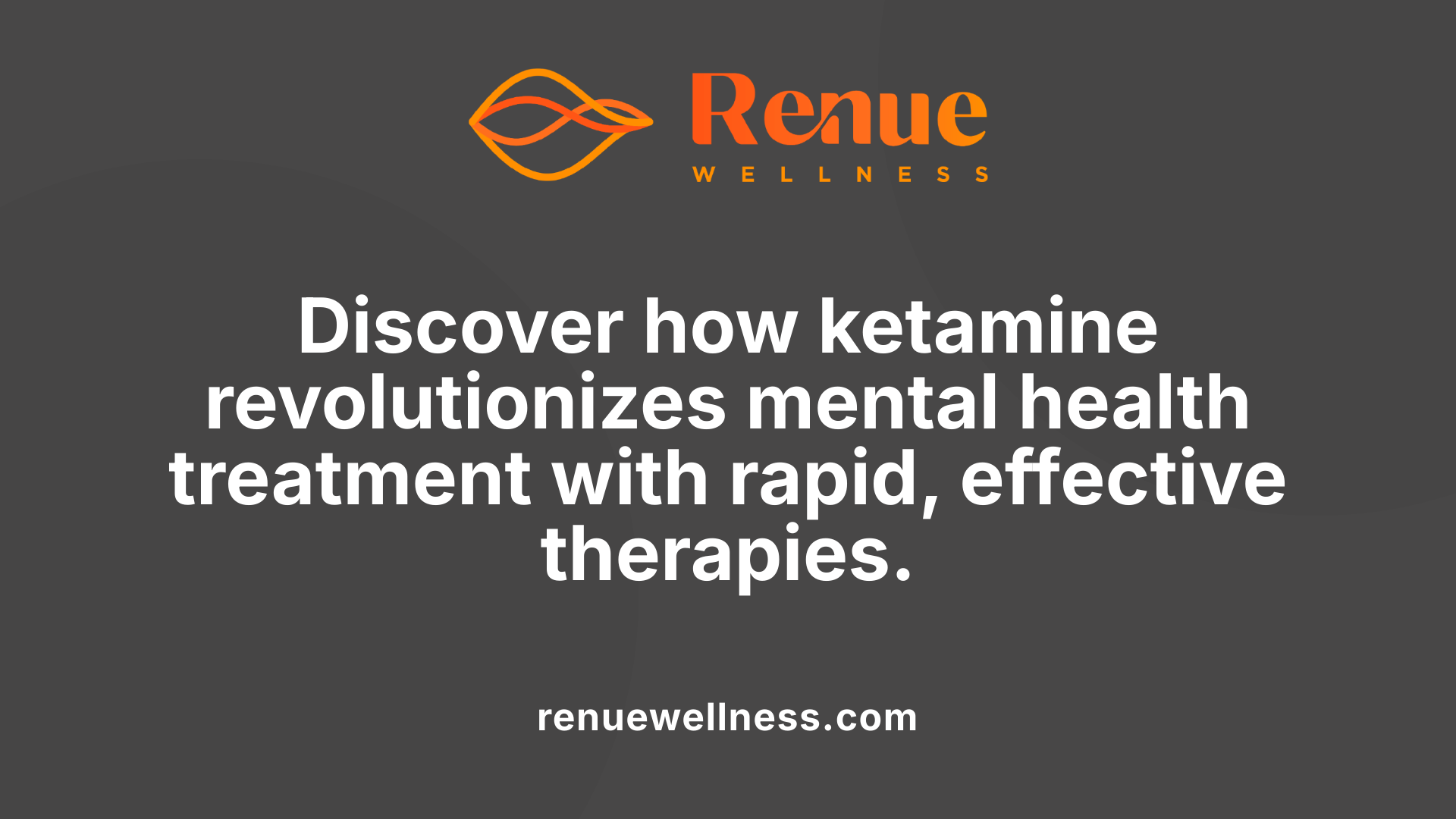Is Ketamine the Future of Mental Health Treatment?


August 7, 2025
Pioneering a New Era in Psychiatric Treatments
Over the past decade, ketamine, once primarily known as an anesthetic, has emerged as a groundbreaking treatment for mental health conditions such as depression, anxiety, and PTSD. Supported by an extensive body of research and clinical trials, it offers rapid relief where traditional therapies often fall short. This article explores whether ketamine is poised to become the future of mental health treatment, examining its mechanisms, efficacy, safety, innovations, and the evolving landscape of psychedelic medicine.
Ketamine’s Historical and Regulatory Background

Development and initial approval as an anesthetic
Ketamine was first developed in 1962 by Dr. Calvin Stevens and received FDA approval in 1970 as a general anesthetic. Its initial use was primarily in veterinary medicine and emergency procedures, especially during the Vietnam War, due to its safety profile and effectiveness in inducing anesthesia. Over the decades, ketamine became a standard anesthetic medication, appreciated for its dissociative effects and minimal respiratory depression.
Off-label use in mental health treatment
In the 2000s, researchers rediscovered ketamine's potential beyond anesthesia. Low-dose ketamine showed rapid antidepressant effects, especially in treatment-resistant depression (TRD). Many clinics began administering ketamine infusions off-label to treat mood disorders, anxiety, PTSD, and suicidal ideation. This off-label use has gained popularity because of ketamine's ability to quickly reduce symptoms, often within hours, in cases unresponsive to traditional antidepressants.
FDA approvals and regulatory considerations
In 2019, the FDA approved esketamine (Spravato), a ketamine derivative delivered via nasal spray, specifically for treatment-resistant depression. This marked a significant regulatory milestone, as it provided a formal approval pathway with strict monitoring and safety protocols. Esketamine's approval also influenced the regulatory environment, encouraging more structured treatment protocols.
However, the traditional form of ketamine remains a Schedule III controlled substance in the US, meaning it is regulated due to potential abuse risks. Clinics offering ketamine infusions operate under medical supervision but are often subject to state regulations, and federal oversight focuses on controlled substance laws. Globally, regulations vary; in some countries, ketamine is classified more strictly, while others permit medical use under specific conditions.
Clinicians must adhere to safety standards, including patient monitoring and proper dosing, to mitigate risks like high blood pressure, dissociation, or misuse. Despite its unapproved status for mental health in many jurisdictions, the strong clinical evidence has supported its ongoing use in specialized treatment settings.
Overall, ketamine's legal use in medicine is well-established for anesthesia and increasingly recognized for mental health, thanks to regulatory approvals for derivatives like esketamine and ongoing studies supporting its safety and efficacy.
How Ketamine and Its Derivatives Work in the Brain
How does ketamine work in the brain to produce its therapeutic effects?
Ketamine’s impact on the brain's neurochemistry underpins its rapid antidepressant action. Its primary mechanism involves blocking NMDA receptors, a type of glutamate receptor critical for neural communication and plasticity. By antagonizing NMDA receptors, especially on GABAergic interneurons, ketamine reduces inhibitory control over excitatory neurons, resulting in a surge of glutamate release.
This increase in glutamate activates AMPA receptors, another class of glutamate receptors, which then stimulates various intracellular signaling pathways. A notable pathway involves the brain-derived neurotrophic factor (BDNF), a protein essential for supporting neuron growth and synaptic plasticity. Activation of BDNF triggers downstream effects involving the mammalian target of rapamycin (mTOR) pathway, leading to rapid formation of new synapses and strengthening of existing neural connections.
Recent research also highlights the role of ketamine's metabolites, such as (2R,6R)-HNK, which appear to exert antidepressant effects without directly inhibiting NMDA receptors. They promote AMPA receptor activity, thereby enhancing neuroplasticity and mood regulation.
This cascade of receptor interactions and intracellular signaling culminates in increased neuroplasticity, particularly in brain regions like the prefrontal cortex and hippocampus. These areas are involved in mood regulation, decision-making, and emotional resilience. The enhanced connectivity within these circuits helps reset disrupted neural pathways associated with depression.
In summary, ketamine’s rapid therapeutic effects stem from a complex interplay of receptor blockade, increased glutamate signaling, neurotrophic support, and synaptogenesis. This chain of events restores neural plasticity, offering quick and lasting relief from depressive symptoms. The development of derivatives like RR-HNK aims to harness these beneficial pathways with fewer side effects, advancing personalized mental health treatments.
Evidence Supporting Ketamine’s Efficacy and Safety

What does current scientific research say about the efficacy and safety of ketamine in mental health care?
Recent findings consistently show that ketamine provides rapid relief for individuals with treatment-resistant depression, often within hours or a few days. Numerous clinical trials, funded by organizations like the NIMH, have demonstrated significant improvement in depressive symptoms, including reductions in suicidal thoughts. For instance, studies reveal that over 70% of patients experience notable symptom reduction after a series of ketamine infusions.
The safety profile of ketamine appears acceptable when administered in a controlled medical setting. Most adverse effects reported are mild and transient, such as dissociation, elevated blood pressure, and mild psychotomimetic effects, which typically resolve shortly after treatment. A recent human study of a ketamine-related compound, RR-HNK, confirmed its safety, showing no serious adverse events and only mild side effects that resolved over time. Participants also demonstrated that RR-HNK entered the brain and remained active for hours, with response levels correlating with dosage.
While evidence supports ketamine's usefulness, long-term effects are still being studied. Concerns about potential abuse, dissociative effects, and unclear optimal treatment protocols mean that careful medical supervision remains essential. Emerging research suggests that psychological factors, such as hope and expectation, may enhance ketamine's antidepressant effects, possibly working alongside its pharmacological action.
Overall, current research reinforces ketamine’s role as a promising, rapid-acting intervention for depression, especially for cases unresponsive to traditional treatments. Its efficacy in reducing suicidal ideation and promoting neuroplasticity marks it as a significant advancement in mental health care, though ongoing studies are vital to better understand its long-term safety and mechanisms of action.
Therapeutic Benefits and Clinical Applications

What are the therapeutic benefits of ketamine for mental health conditions?
Ketamine has proven to be a rapid and effective treatment for various mental health issues, especially treatment-resistant depression, anxiety disorders, and post-traumatic stress disorder (PTSD). Its ability to deliver symptom relief within hours to days makes it uniquely valuable in urgent situations, including cases of suicidal thoughts. Clinical studies have demonstrated that ketamine can significantly reduce depressive symptoms, often when other therapies have failed.
The way ketamine works involves blocking NMDA receptors in the brain, which leads to an increase in glutamate release. This process promotes neuroplasticity, encouraging the growth of new synapses—tiny connections between neurons—mainly in regions such as the prefrontal cortex and hippocampus. These are critical areas involved in mood regulation and cognitive functions.
Beyond mood improvement, ketamine may help reestablish damaged neural circuits, resulting in a more resilient brain network. This neuroplastic effect can break the cycle of negative thoughts and emotional rigidity typical of severe depression.
In addition to improving mood, ketamine reduces suicidal ideation markedly, often within hours post-treatment. This rapid impact provides an essential window of safety and stabilization, especially for high-risk patients.
Clinicians typically administer ketamine via intravenous infusions, nasal sprays, or other methods like intramuscular injections, under strict medical supervision. Usually, a series of sessions is necessary to achieve and maintain optimal benefits, which can last from several days to weeks. Ongoing research continues to explore optimal protocols for dosage and frequency to extend the longevity of recovery.
While generally safe when monitored properly, ketamine’s use must consider potential side effects such as dissociation, high blood pressure, or dissociative experiences. As such, it remains an important option for individuals with severe, treatment-resistant mental health conditions, complementing psychological therapies and other interventions.
Emerging Trends, Innovations, and Expanded Uses

What are emerging trends and innovations in ketamine-based therapies?
The landscape of ketamine therapy is rapidly evolving, with several notable innovations aimed at improving safety, efficacy, and accessibility. One major trend involves the development of new delivery methods such as nasal sprays, infusions, and oral formulations. Esketamine nasal spray (Spravato) has already gained FDA approval for treatment-resistant depression, promoting easier, outpatient administration. Researchers are also exploring oral tablets and dissolvable lozenges that could make treatment more convenient.
Personalized infusion protocols are another focus area. Clinics are experimenting with tailoring treatment doses and schedules based on individual patient responses, often informed by biological markers or genetic data. This approach aims to optimize benefits while reducing the risk of adverse effects.
Combining ketamine treatment with psychotherapy is gaining traction, especially in outpatient settings. Integrating behavioral therapies, mindfulness, and cognitive restructuring can enhance treatment outcomes by addressing underlying emotional patterns.
A novel addition to the therapeutic toolkit is the use of digital tools like virtual reality (VR). Virtual reality-guided meditation and relaxation techniques are employed during or immediately before ketamine sessions. This technology aims to reduce anxiety, improve patient engagement, and facilitate emotional processing.
Incorporating VR allows for immersive experiences that can promote neuroplasticity and help patients manage treatment-related dissociation or discomfort. Additionally, digital applications support ongoing monitoring, personalized feedback, and remote care, expanding access for underserved populations.
Beyond depression, ketamine is expanding into broader applications like chronic pain management and post-traumatic stress disorder (PTSD). Its neuroplastic and anti-inflammatory properties make it suitable for these conditions, with innovative formulations and treatment settings being developed.
The future of ketamine therapy looks towards comprehensive, holistic treatment plans that combine pharmacological, psychological, and technological interventions. With ongoing research, these advances promise to make ketamine treatments safer, more effective, and available to a wider range of patients.
Future Prospects and Broader Applications in Psychedelic Medicine
 The outlook for ketamine and other psychedelic treatments in mental health care is increasingly optimistic. Regulatory agencies are gradually moving towards more formal recognition of these therapies, with some drugs earning breakthrough therapy status. This accelerated pathway may lead to wider acceptance and adoption in clinical practice.
The outlook for ketamine and other psychedelic treatments in mental health care is increasingly optimistic. Regulatory agencies are gradually moving towards more formal recognition of these therapies, with some drugs earning breakthrough therapy status. This accelerated pathway may lead to wider acceptance and adoption in clinical practice.
Currently, research demonstrates that these substances can effectively treat a range of conditions beyond depression, including post-traumatic stress disorder (PTSD), anxiety disorders, and even end-of-life psychological distress. Their ability to rapidly promote neuroplasticity—brain's capacity to rewire itself—and modify neural connectivity opens up new avenues for personalized treatments tailored to individual biological and genetic profiles.
Moreover, innovative formulations are being developed to enhance safety and reduce side effects. These include non-hallucinogenic derivatives and shorter-acting versions designed to minimize perceptual disturbances while maintaining therapeutic efficacy.
Researchers are also exploring ways to integrate psychedelic-assisted therapy with conventional psychotherapy, creating comprehensive treatment models that leverage the neurochemical effects of these drugs to enhance mental health outcomes.
In the future, the combination of regulatory support, scientific advances, and new drug development could significantly change current mental health treatment paradigms. Such progress may make these treatments more accessible and safer, promoting their role as a mainstream option for treating difficult mental health conditions—offering hope for patients who have not responded to standard therapies.
The Transformative Potential of Ketamine and Psychedelic Therapies
As scientific research continues to validate ketamine’s rapid and durable antidepressant effects, along with innovations in delivery and personalized protocols, it is increasingly positioned as a pivotal future therapy for mental health disorders. Its ability to rewire neural circuits and stimulate neuroplasticity opens new horizons for treating conditions resistant to traditional methods. Regulatory progress, expanding indications, and ongoing clinical trials suggest that ketamine, coupled with emerging psychedelic medicines, may fundamentally reshape psychiatric care—making mental health treatment faster, more effective, and accessible. While challenges remain, including regulatory oversight and long-term safety considerations, the overall outlook for ketamine as a cornerstone of modern mental health medicine is highly optimistic and poised to redefine the future of psychological treatment.
References
- New Hope for Rapid-Acting Depression Treatment
- Ketamine: A Rising Star in Mental Health Treatment - ADAA.org
- Ketamine economy: New mental health clinics pop up with few rules
- Ketamine's promise for severe depression grows, but major ...
- Ketamine: Leading us into the future for development of ...
- The Future of Mental Health: Ketamine and Its Evolving Role
- Ketamine for Mental Health Should Only be Provided by Trained ...
- Revolutionizing Mental Health Care with Ketamine Infusions
- John Krystal, MD: Exploring the Future of Ketamine and Psychedelic ...
Recent Posts
Conditions Treated
AnxietyDepressionOCDPTSDPostpartum DepressionPain ManagementSubstance AbuseSuicidal IdeationOur Location


